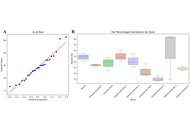
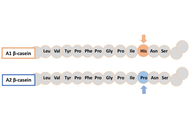
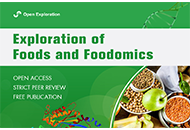
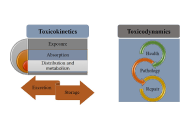
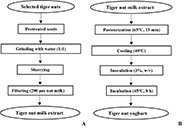
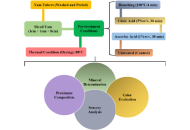

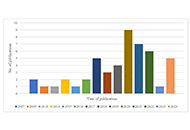
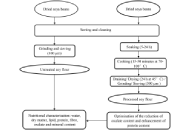
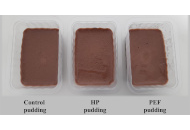
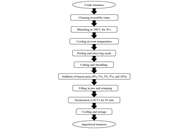
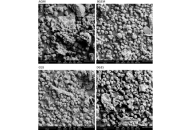









Aim:
Colombia’s economy relies heavily on agriculture, with Hass avocado (Persea americana) playing a key role. This fruit consists of exocarp, mesocarp, and endocarp, with the mesocarp being the most consumed part due to its rich composition of saturated and unsaturated fatty acids (omegas), which offer valuable nutritional properties. This study analyzed the lipid composition of Hass avocado from the northern subregion of the Caldas department and evaluated the variability in lipid content across cultivation zones based on metabolite profiles.
Methods:
Lipids were extracted from avocado samples, derivatized, and analyzed using gas chromatography-mass spectrometry (GC-MS) for lipidome characterization. Statistical analyses determined fat content variability across zones, and metabolic pathways involved in lipid biosynthesis were explored.
Results:
Fat content ranged from 10.27% to 59.04%, with significant differences observed between cultivation zones (ANOVA: p = 0.0102 for Aranzazu Business 1; p = 0.03918 for Salamina Business 1). GC-MS analysis identified 143 chromatographic signals, including 60 known metabolites, with major fatty acids such as myristic, palmitic, tridecanoic, palmitoleic (omega-7), and oleic (omega-9) acids. The identified functional groups comprised 28.3% alkanes, 21.7% aldehydes, 18.3% esters (derivatives of the derivatization process), and 11.7% alcohols. The observed regional lipid variability suggests that environmental and agronomic factors modulate fatty acid biosynthesis, potentially through adjustments in pathways such as the mevalonate route.
Conclusions:
This lipidomic approximation confirms the presence of bioactive omega-7 and omega-9 fatty acids, reinforcing the nutritional significance of Hass avocado and highlighting its potential cardiovascular benefits. The demonstrated variability across cultivation zones emphasizes the influence of local environmental conditions on lipid profiles. These findings contribute to the understanding of avocado lipid metabolism and provide valuable insights for optimizing cultivation practices, improving fruit quality, and informing functional food development.
Aim:
Colombia’s economy relies heavily on agriculture, with Hass avocado (Persea americana) playing a key role. This fruit consists of exocarp, mesocarp, and endocarp, with the mesocarp being the most consumed part due to its rich composition of saturated and unsaturated fatty acids (omegas), which offer valuable nutritional properties. This study analyzed the lipid composition of Hass avocado from the northern subregion of the Caldas department and evaluated the variability in lipid content across cultivation zones based on metabolite profiles.
Methods:
Lipids were extracted from avocado samples, derivatized, and analyzed using gas chromatography-mass spectrometry (GC-MS) for lipidome characterization. Statistical analyses determined fat content variability across zones, and metabolic pathways involved in lipid biosynthesis were explored.
Results:
Fat content ranged from 10.27% to 59.04%, with significant differences observed between cultivation zones (ANOVA: p = 0.0102 for Aranzazu Business 1; p = 0.03918 for Salamina Business 1). GC-MS analysis identified 143 chromatographic signals, including 60 known metabolites, with major fatty acids such as myristic, palmitic, tridecanoic, palmitoleic (omega-7), and oleic (omega-9) acids. The identified functional groups comprised 28.3% alkanes, 21.7% aldehydes, 18.3% esters (derivatives of the derivatization process), and 11.7% alcohols. The observed regional lipid variability suggests that environmental and agronomic factors modulate fatty acid biosynthesis, potentially through adjustments in pathways such as the mevalonate route.
Conclusions:
This lipidomic approximation confirms the presence of bioactive omega-7 and omega-9 fatty acids, reinforcing the nutritional significance of Hass avocado and highlighting its potential cardiovascular benefits. The demonstrated variability across cultivation zones emphasizes the influence of local environmental conditions on lipid profiles. These findings contribute to the understanding of avocado lipid metabolism and provide valuable insights for optimizing cultivation practices, improving fruit quality, and informing functional food development.
DOI: https://doi.org/10.37349/eff.2025.1010100

The health benefits of milk have been acknowledged throughout human history, with scientific research over the past 50 years elucidating its nutritional composition and functional benefits. This article presents a contemporary analysis of modern casein chemistry, emphasizing the specialized engineering of dairy proteins for optimizing resource utilization. It explores the unique structure of casein micelles as supramolecular complexes, where ionic interactions promote electron sharing between phosphoserines and calcium phosphate nanoclusters. This review aims to synthesize recent literature on casein nanocomplexes and explore their potential in industrial applications such as drug delivery and sustainable food engineering. Casein-based bio-nanocomposites have emerged as a significant research interest in food science, offering considerable potential for a wide array of scientific applications, such as drug formulation and nutraceutical delivery. It is crucial for scientists to engage in ongoing research and development efforts to encourage sustainable progress, enhance commercial viability, improve manufacturing processes, and expand the engineering applications of casein micelles toward fostering an eco-friendly industry.
The health benefits of milk have been acknowledged throughout human history, with scientific research over the past 50 years elucidating its nutritional composition and functional benefits. This article presents a contemporary analysis of modern casein chemistry, emphasizing the specialized engineering of dairy proteins for optimizing resource utilization. It explores the unique structure of casein micelles as supramolecular complexes, where ionic interactions promote electron sharing between phosphoserines and calcium phosphate nanoclusters. This review aims to synthesize recent literature on casein nanocomplexes and explore their potential in industrial applications such as drug delivery and sustainable food engineering. Casein-based bio-nanocomposites have emerged as a significant research interest in food science, offering considerable potential for a wide array of scientific applications, such as drug formulation and nutraceutical delivery. It is crucial for scientists to engage in ongoing research and development efforts to encourage sustainable progress, enhance commercial viability, improve manufacturing processes, and expand the engineering applications of casein micelles toward fostering an eco-friendly industry.
DOI: https://doi.org/10.37349/eff.2025.101099

Aim:
Fruits from the tropical Annona genus of family Annonaceae have long been cultivated in tropical Latin America, Africa, and southeastern Asia. Asimina triloba is a temperate fruit from Annonaceae, but few comparisons between Annonaceae fruits exist. The objective was to determine how 21 days of refrigerated storage affected the carotenoids and color in ripe and overripe A. triloba. A comparison to tropical Annonaceae fruits is provided.
Methods:
Pawpaw pulp was stored refrigerated for 21 days. Total carotenoids and β-carotene were determined spectrophotometrically and by HPLC, respectively. C.I.E. L*, a*, and b* values were used to calculate hue angle, chroma, total color change (ΔE), browning index, which have been reported in A. triloba previously, and color index, whiteness index, yellowness index, the ratio of a*/b*, and percent change in L*, which are reported herein for the first time.
Results:
Overripe pulp contains 5-fold more carotenoids than ripe pulp. A significant decline in total carotenoids was observed during refrigerated storage in the overripe pulp, but not in fresh pulp. At the onset of refrigerated storage, ripe pulp was significantly less brown than overripe pulp, but became more brown during refrigerated storage. No further change in browning was observed during storage of overripe pulp.
Conclusions:
Using established conversion factors and the values generated in this study, preliminary indications are that ripe A. triloba pulp provides 4.0% (males) and 5.1% (females) of the U.S. Recommended Dietary Allowance (USRDA) of vitamin A for individuals 14 years or older, and overripe provides 3.5% and 4.6%. Carotenoids are well-characterized for Annona muricata (A. muricata), Annona reticulata (A. reticulata), and Annona squamosa (A. squamosa), but these provide less than 1% of the USRDA of vitamin A. A comparison revealed that Annonaceae fruit are nutrient-dense, provide fiber and potassium, are low in fat and protein, and have comparable calcium, iron, magnesium, potassium, and sodium levels. Understanding Annonaceae fruits nutritional value may facilitate increased economic potential.
Aim:
Fruits from the tropical Annona genus of family Annonaceae have long been cultivated in tropical Latin America, Africa, and southeastern Asia. Asimina triloba is a temperate fruit from Annonaceae, but few comparisons between Annonaceae fruits exist. The objective was to determine how 21 days of refrigerated storage affected the carotenoids and color in ripe and overripe A. triloba. A comparison to tropical Annonaceae fruits is provided.
Methods:
Pawpaw pulp was stored refrigerated for 21 days. Total carotenoids and β-carotene were determined spectrophotometrically and by HPLC, respectively. C.I.E. L*, a*, and b* values were used to calculate hue angle, chroma, total color change (ΔE), browning index, which have been reported in A. triloba previously, and color index, whiteness index, yellowness index, the ratio of a*/b*, and percent change in L*, which are reported herein for the first time.
Results:
Overripe pulp contains 5-fold more carotenoids than ripe pulp. A significant decline in total carotenoids was observed during refrigerated storage in the overripe pulp, but not in fresh pulp. At the onset of refrigerated storage, ripe pulp was significantly less brown than overripe pulp, but became more brown during refrigerated storage. No further change in browning was observed during storage of overripe pulp.
Conclusions:
Using established conversion factors and the values generated in this study, preliminary indications are that ripe A. triloba pulp provides 4.0% (males) and 5.1% (females) of the U.S. Recommended Dietary Allowance (USRDA) of vitamin A for individuals 14 years or older, and overripe provides 3.5% and 4.6%. Carotenoids are well-characterized for Annona muricata (A. muricata), Annona reticulata (A. reticulata), and Annona squamosa (A. squamosa), but these provide less than 1% of the USRDA of vitamin A. A comparison revealed that Annonaceae fruit are nutrient-dense, provide fiber and potassium, are low in fat and protein, and have comparable calcium, iron, magnesium, potassium, and sodium levels. Understanding Annonaceae fruits nutritional value may facilitate increased economic potential.
DOI: https://doi.org/10.37349/eff.2025.101098

The contamination of food by toxic chemical compounds is a significant global concern that threatens food safety and public health. These compounds originate from diverse sources, including naturally occurring toxins such as mycotoxins and plant alkaloids, environmental pollutants including heavy metals and persistent organic pollutants, substances formed during food processing and packaging such as acrylamide and bisphenol A, and newly emerging contaminants such as microplastics and nanoplastics. This review presents a comprehensive classification of toxic compounds in the food system, detailing their sources, persistence, and behavior within the environment. The objective of this study is to explore the toxicity, toxicokinetics, and toxicodynamics of foodborne contaminants by examining their absorption, distribution, metabolism, excretion, and mechanisms of biotransformation. The review also discusses how these toxicants interact with cellular and molecular targets, leading to adverse effects on various organs and biological systems. Furthermore, the manuscript highlights both conventional detection methods such as immunoassays, chromatographic and spectroscopic techniques, biochemical and microbiological assay, and recent innovations, including nanotechnology-based biosensors and computational tools driven by artificial intelligence. A novel contribution of this review is the inclusion of standardized chemical identifiers such as systematic names by the International Union of Pure and Applied Chemistry, the International Chemical Identifier, the Simplified Molecular Input Line Entry Specification, and the Chemical Abstracts Service Registry Number used in food-risk component databases. Additionally, the application of the One Health approach offers an integrated perspective on human, animal, and environmental health. This review identifies research gaps and promotes enhanced monitoring, regulation, and management strategies to ensure sustainable food safety.
The contamination of food by toxic chemical compounds is a significant global concern that threatens food safety and public health. These compounds originate from diverse sources, including naturally occurring toxins such as mycotoxins and plant alkaloids, environmental pollutants including heavy metals and persistent organic pollutants, substances formed during food processing and packaging such as acrylamide and bisphenol A, and newly emerging contaminants such as microplastics and nanoplastics. This review presents a comprehensive classification of toxic compounds in the food system, detailing their sources, persistence, and behavior within the environment. The objective of this study is to explore the toxicity, toxicokinetics, and toxicodynamics of foodborne contaminants by examining their absorption, distribution, metabolism, excretion, and mechanisms of biotransformation. The review also discusses how these toxicants interact with cellular and molecular targets, leading to adverse effects on various organs and biological systems. Furthermore, the manuscript highlights both conventional detection methods such as immunoassays, chromatographic and spectroscopic techniques, biochemical and microbiological assay, and recent innovations, including nanotechnology-based biosensors and computational tools driven by artificial intelligence. A novel contribution of this review is the inclusion of standardized chemical identifiers such as systematic names by the International Union of Pure and Applied Chemistry, the International Chemical Identifier, the Simplified Molecular Input Line Entry Specification, and the Chemical Abstracts Service Registry Number used in food-risk component databases. Additionally, the application of the One Health approach offers an integrated perspective on human, animal, and environmental health. This review identifies research gaps and promotes enhanced monitoring, regulation, and management strategies to ensure sustainable food safety.
DOI: https://doi.org/10.37349/eff.2025.101097

Aim:
Underexploited local plant resources, such as tiger nuts, have significant nutritional potential. Tiger nuts can be used to produce a plant-based yoghurt that would enable people suffering from lactose intolerance to enjoy its benefits. This study aimed to evaluate the sensory acceptability, physicochemical, and nutritional properties of a yoghurt-like product made with tiger nuts pretreated by various methods (soaking, drying, roasting, boiling, and germination).
Methods:
Six types of vegetable yoghurt were produced from the milk obtained after different pretreatment methods (soaking, germination, roasting, drying, and boiling) of tiger nuts. A control sample was made of untreated tiger nuts. Nutritional analyses were carried out using conventional methods. Quantifying bioactive and antinutrient compounds was conducted via spectrophotometry and titration methods. Physicochemical analysis of samples was also carried out. A consumer preference test was conducted using an untrained panel.
Results:
Yoghurt samples made with tiger nuts, pretreated through roasting, showed the best sensory characteristics and overall acceptability. Drying of tiger nuts resulted in a significantly higher energy value, as did the protein content (5.46%) in the germinated yoghurt and the fibre content (2.80%) in the boiled yoghurt. Syneresis and water holding capacity decrease slightly during all the pretreatment methods applied. With regards to bioactive compounds, phenolic compounds [393.39 mg GAE (gallic acid equivalent)/100 g DM (dry matter)] were more abundant in the yoghurt whose seeds were boiled, while the content of alkaloids [1,178.08 mg QE (quinine equivalent)/100 g DM] was higher in the products made with roasted tiger nuts. Roasting and germination were respectively the most effective pretreatment methods for the reduction of the amount of phytate and saponin.
Conclusions:
Production of yoghurt with roasted tiger nuts appears to be the best option in terms of its sensory attributes and its nutritional properties. Its consumption will contribute significantly to improving the nutrient and bioactive compounds intake for those suffering from lactose intolerance.
Aim:
Underexploited local plant resources, such as tiger nuts, have significant nutritional potential. Tiger nuts can be used to produce a plant-based yoghurt that would enable people suffering from lactose intolerance to enjoy its benefits. This study aimed to evaluate the sensory acceptability, physicochemical, and nutritional properties of a yoghurt-like product made with tiger nuts pretreated by various methods (soaking, drying, roasting, boiling, and germination).
Methods:
Six types of vegetable yoghurt were produced from the milk obtained after different pretreatment methods (soaking, germination, roasting, drying, and boiling) of tiger nuts. A control sample was made of untreated tiger nuts. Nutritional analyses were carried out using conventional methods. Quantifying bioactive and antinutrient compounds was conducted via spectrophotometry and titration methods. Physicochemical analysis of samples was also carried out. A consumer preference test was conducted using an untrained panel.
Results:
Yoghurt samples made with tiger nuts, pretreated through roasting, showed the best sensory characteristics and overall acceptability. Drying of tiger nuts resulted in a significantly higher energy value, as did the protein content (5.46%) in the germinated yoghurt and the fibre content (2.80%) in the boiled yoghurt. Syneresis and water holding capacity decrease slightly during all the pretreatment methods applied. With regards to bioactive compounds, phenolic compounds [393.39 mg GAE (gallic acid equivalent)/100 g DM (dry matter)] were more abundant in the yoghurt whose seeds were boiled, while the content of alkaloids [1,178.08 mg QE (quinine equivalent)/100 g DM] was higher in the products made with roasted tiger nuts. Roasting and germination were respectively the most effective pretreatment methods for the reduction of the amount of phytate and saponin.
Conclusions:
Production of yoghurt with roasted tiger nuts appears to be the best option in terms of its sensory attributes and its nutritional properties. Its consumption will contribute significantly to improving the nutrient and bioactive compounds intake for those suffering from lactose intolerance.
DOI: https://doi.org/10.37349/eff.2025.101096

Aim:
This study examined the combined effects of pretreatment methods (blanching, citric acid, and ascorbic acid) and oven drying on the chemical composition and sensory quality of fried yam (Dioscorea rotundata) chips, aimed at optimizing processing conditions for improved product quality.
Methods:
Fresh yam slices were subjected to three pretreatment conditions: blanching (4 min at 100°C), a 5% citric acid solution, and a 1% ascorbic acid solution, compared to the untreated samples (control). All samples underwent convective drying at 80°C with an air velocity of 2.0 m/s. The proximate composition and mineral content of the dried samples were evaluated using official methods of food analysis and atomic absorption spectroscopy, respectively, while the color parameters and sensory evaluations of the fried yam chips were conducted using a colorimeter and a nine-point hedonic scale.
Results:
Both pretreatment and drying significantly (p < 0.05) influenced mineral content in the dried yam chips. In comparison to the control, all proximate constituents decreased after drying, except for carbohydrates, which increased in the dried pre-treated samples. The fried samples of yam chips that had been blanched for 4 min received higher acceptability scores for taste, color, crispiness, and overall acceptability on the sensory scale, compared to samples pre-treated with 1% ascorbic acid and 5% citric acid. However, the acid pre-treated samples demonstrated the least browning effect in the fried products.
Conclusions:
The processes of pretreatment and drying significantly modified both the mineral and proximate composition of the yam chips, increasing carbohydrates while other components decreased post-processing. Blanched samples exhibited superior sensory acceptability across all attributes, while the acid pretreatments effectively reduced browning in the final fried products.
Aim:
This study examined the combined effects of pretreatment methods (blanching, citric acid, and ascorbic acid) and oven drying on the chemical composition and sensory quality of fried yam (Dioscorea rotundata) chips, aimed at optimizing processing conditions for improved product quality.
Methods:
Fresh yam slices were subjected to three pretreatment conditions: blanching (4 min at 100°C), a 5% citric acid solution, and a 1% ascorbic acid solution, compared to the untreated samples (control). All samples underwent convective drying at 80°C with an air velocity of 2.0 m/s. The proximate composition and mineral content of the dried samples were evaluated using official methods of food analysis and atomic absorption spectroscopy, respectively, while the color parameters and sensory evaluations of the fried yam chips were conducted using a colorimeter and a nine-point hedonic scale.
Results:
Both pretreatment and drying significantly (p < 0.05) influenced mineral content in the dried yam chips. In comparison to the control, all proximate constituents decreased after drying, except for carbohydrates, which increased in the dried pre-treated samples. The fried samples of yam chips that had been blanched for 4 min received higher acceptability scores for taste, color, crispiness, and overall acceptability on the sensory scale, compared to samples pre-treated with 1% ascorbic acid and 5% citric acid. However, the acid pre-treated samples demonstrated the least browning effect in the fried products.
Conclusions:
The processes of pretreatment and drying significantly modified both the mineral and proximate composition of the yam chips, increasing carbohydrates while other components decreased post-processing. Blanched samples exhibited superior sensory acceptability across all attributes, while the acid pretreatments effectively reduced browning in the final fried products.
DOI: https://doi.org/10.37349/eff.2025.101095
This article belongs to the special issue The food (r)evolution towards food quality/security and human nutrition

Aim:
This study examined the knowledge and consumption patterns of fermented foods among undergraduate students, comparing those enrolled in Food and Nutrition programs with students from other academic disciplines.
Methods:
A cross-sectional survey of 328 Canadian university students gathered demographic data and assessed familiarity, understanding, and intake of fermented food products.
Results:
While 78% of students reported familiarity with fermented foods, only 23% could accurately define fermentation. Students in Food and Nutrition programs demonstrated stronger knowledge, correctly answering 67% of related questions versus 62% in other disciplines (p = 0.07; 90% CI). Consumption rates were high overall, with 96% of participants reporting they consumed fermented foods. Significant differences were found between groups in specific categories: fermented fruits and vegetables (p = 0.02), soybeans (p = 0.002), grains (p = 0.02), and meat products (p = 0.017). Regarding frequency, 36% of students consumed a variety of fermented foods weekly, while 30% reported monthly consumption.
Conclusions:
Cultural background, taste preference, and educational focus also appear to influence dietary behaviors. Enrollment in a Food and Nutrition program was linked to both higher knowledge and increased intake. To the best of our knowledge, this is the first Canadian study to explore differences in fermented food knowledge and consumption across academic disciplines. These results support the potential of education-based strategies to promote healthier dietary patterns and warrant further research across more diverse populations.
Aim:
This study examined the knowledge and consumption patterns of fermented foods among undergraduate students, comparing those enrolled in Food and Nutrition programs with students from other academic disciplines.
Methods:
A cross-sectional survey of 328 Canadian university students gathered demographic data and assessed familiarity, understanding, and intake of fermented food products.
Results:
While 78% of students reported familiarity with fermented foods, only 23% could accurately define fermentation. Students in Food and Nutrition programs demonstrated stronger knowledge, correctly answering 67% of related questions versus 62% in other disciplines (p = 0.07; 90% CI). Consumption rates were high overall, with 96% of participants reporting they consumed fermented foods. Significant differences were found between groups in specific categories: fermented fruits and vegetables (p = 0.02), soybeans (p = 0.002), grains (p = 0.02), and meat products (p = 0.017). Regarding frequency, 36% of students consumed a variety of fermented foods weekly, while 30% reported monthly consumption.
Conclusions:
Cultural background, taste preference, and educational focus also appear to influence dietary behaviors. Enrollment in a Food and Nutrition program was linked to both higher knowledge and increased intake. To the best of our knowledge, this is the first Canadian study to explore differences in fermented food knowledge and consumption across academic disciplines. These results support the potential of education-based strategies to promote healthier dietary patterns and warrant further research across more diverse populations.
DOI: https://doi.org/10.37349/eff.2025.101093

Heavy metal contamination of food is a critical global health issue due to its toxic, bioaccumulative, and often carcinogenic effects. This study presents a comprehensive bibliometric analysis of research published between 2000 and 2024 on health risk assessments associated with heavy metal exposure through the consumption of cereal products. Data were extracted from the Web of Science database and analyzed using VOSviewer software to visualize trends in terms of authors, institutional and international collaboration, and areas of thematic interest. The findings reveal a growing scientific interest in this field, with a peak in publication volume in 2020. China emerged as the main contributor, accounting for almost half of all publications, followed by Iran, Spain, and Brazil. The Chinese Academy of Sciences and Shahid Beheshti University of Medical Sciences were among the most active institutions. Journals such as Environmental Science and Pollution Research and Science of the Total Environment were identified as key publication platforms. The collaborative analysis highlights China and the USA as major centres of international collaboration, with peripheral but active contributions from countries such as England, Bangladesh, and Malaysia. Most studies focused on exposure pathways and assessed both carcinogenic and non-carcinogenic health risks, frequently reporting values above safe thresholds. These findings highlight the urgent need for national long-term monitoring programmes and the development of country-specific strategies to reduce exposure to heavy metals in food, thereby enhancing public health protection and regulatory compliance.
Heavy metal contamination of food is a critical global health issue due to its toxic, bioaccumulative, and often carcinogenic effects. This study presents a comprehensive bibliometric analysis of research published between 2000 and 2024 on health risk assessments associated with heavy metal exposure through the consumption of cereal products. Data were extracted from the Web of Science database and analyzed using VOSviewer software to visualize trends in terms of authors, institutional and international collaboration, and areas of thematic interest. The findings reveal a growing scientific interest in this field, with a peak in publication volume in 2020. China emerged as the main contributor, accounting for almost half of all publications, followed by Iran, Spain, and Brazil. The Chinese Academy of Sciences and Shahid Beheshti University of Medical Sciences were among the most active institutions. Journals such as Environmental Science and Pollution Research and Science of the Total Environment were identified as key publication platforms. The collaborative analysis highlights China and the USA as major centres of international collaboration, with peripheral but active contributions from countries such as England, Bangladesh, and Malaysia. Most studies focused on exposure pathways and assessed both carcinogenic and non-carcinogenic health risks, frequently reporting values above safe thresholds. These findings highlight the urgent need for national long-term monitoring programmes and the development of country-specific strategies to reduce exposure to heavy metals in food, thereby enhancing public health protection and regulatory compliance.
DOI: https://doi.org/10.37349/eff.2025.101094
This article belongs to the special issue Food Contaminants: Analysis, Occurrence and Risk Assessment

Aim:
Soya (Glycine max L.) is a legume rich in nutrients (proteins, lipids, carbohydrates, and minerals) but also in anti-nutrients such as oxalate, which hampers the bioavailability of nutrients. The various processes used to treat it reduce the anti-nutrient content while affecting the protein content to a greater or lesser extent. This study aimed to evaluate the impact of a soaking period followed by cooking on the reduction of oxalates and enhancement of protein availability in soya flour.
Methods:
To achieve this, the response surface methodology with the centred composite design was used to reduce the oxalate content and increase the protein content of cooked soya flour. The factors chosen were soaking time (5–24 h), cooking time (15–50 min), and cooking temperature (70–100°C). The soya flours obtained were characterised for protein and oxalate content using standard methods. The optimal samples were also characterised.
Results:
The results obtained showed that cooking and soaking times, followed by the quadratic effect of soaking time, significantly (p < 0.05) increase the protein content and decrease the oxalate content. In terms of optimal conditions, a soaking time of 25.44 h, a cooking temperature of 101.05°C, and a cooking time of 61.93 min reduced the oxalate content by 87.43% and also increased the protein content from 35.98 g/100 g DM to 49.16 g/100 g DM. Optimal conditions of the different treatments also increase lipids, reducing sugar, and the main minerals like Ca, P, Mg, and Fe.
Conclusions:
The application of such conditions would help to combat protein deficiencies.
Aim:
Soya (Glycine max L.) is a legume rich in nutrients (proteins, lipids, carbohydrates, and minerals) but also in anti-nutrients such as oxalate, which hampers the bioavailability of nutrients. The various processes used to treat it reduce the anti-nutrient content while affecting the protein content to a greater or lesser extent. This study aimed to evaluate the impact of a soaking period followed by cooking on the reduction of oxalates and enhancement of protein availability in soya flour.
Methods:
To achieve this, the response surface methodology with the centred composite design was used to reduce the oxalate content and increase the protein content of cooked soya flour. The factors chosen were soaking time (5–24 h), cooking time (15–50 min), and cooking temperature (70–100°C). The soya flours obtained were characterised for protein and oxalate content using standard methods. The optimal samples were also characterised.
Results:
The results obtained showed that cooking and soaking times, followed by the quadratic effect of soaking time, significantly (p < 0.05) increase the protein content and decrease the oxalate content. In terms of optimal conditions, a soaking time of 25.44 h, a cooking temperature of 101.05°C, and a cooking time of 61.93 min reduced the oxalate content by 87.43% and also increased the protein content from 35.98 g/100 g DM to 49.16 g/100 g DM. Optimal conditions of the different treatments also increase lipids, reducing sugar, and the main minerals like Ca, P, Mg, and Fe.
Conclusions:
The application of such conditions would help to combat protein deficiencies.
DOI: https://doi.org/10.37349/eff.2025.101091

Aim:
Despite being a fruit rich in resistant starch, acorns remain undervalued. Resistant starch is known to improve food acceptability when compared to traditional insoluble fibers, and recent research suggests the usage of acorn starch as an additive in fermented yogurt and milk products. Furthermore, non-thermal technologies such as high hydrostatic pressure and pulsed electric field can produce clean-labelled starches. Milk puddings are widely consumed all over the world and are usually produced using representative amounts of starch, making them an enticing food matrix for incorporating acorn starches. Hence, the effects of replacing commercial corn starch with acorn starch extracted by high hydrostatic pressure and pulsed electric field on the nutritional composition, functional and sensorial properties, and shelf-life of puddings were studied.
Methods:
Extraction of starch from Quercus robur acorns was performed using high hydrostatic pressure or pulsed electric field. Extracted starch was used in chocolate puddings, replacing commercial corn starch. Shelf-life storage and microbiological analysis were conducted over 28 days, along with texture, color, pH, and nutritional composition assessments. Rheological properties, scanning electron microscopy, in vitro digestion, and soluble sugar, fatty acid, and salt content analyses were performed. Sensorial analysis was conducted with 71 volunteer panelists to evaluate the acceptability, preference, and similarity of puddings.
Results:
Replacing the commercial corn starch with acorn starch improves the rheological properties of puddings and has no negative impact on the nutritional composition, internal structure, or in vitro digestibility. Sensory analysis revealed that panelists preferred the acorn starch puddings over the control. After 28 days of storage at 4°C, there was a greater stabilization of the color parameters and an improvement in textural parameters of puddings without compromising microbial safety.
Conclusions:
This study demonstrates the potential usage of starch from acorns in food applications, a fruit that is so undervalued.
Aim:
Despite being a fruit rich in resistant starch, acorns remain undervalued. Resistant starch is known to improve food acceptability when compared to traditional insoluble fibers, and recent research suggests the usage of acorn starch as an additive in fermented yogurt and milk products. Furthermore, non-thermal technologies such as high hydrostatic pressure and pulsed electric field can produce clean-labelled starches. Milk puddings are widely consumed all over the world and are usually produced using representative amounts of starch, making them an enticing food matrix for incorporating acorn starches. Hence, the effects of replacing commercial corn starch with acorn starch extracted by high hydrostatic pressure and pulsed electric field on the nutritional composition, functional and sensorial properties, and shelf-life of puddings were studied.
Methods:
Extraction of starch from Quercus robur acorns was performed using high hydrostatic pressure or pulsed electric field. Extracted starch was used in chocolate puddings, replacing commercial corn starch. Shelf-life storage and microbiological analysis were conducted over 28 days, along with texture, color, pH, and nutritional composition assessments. Rheological properties, scanning electron microscopy, in vitro digestion, and soluble sugar, fatty acid, and salt content analyses were performed. Sensorial analysis was conducted with 71 volunteer panelists to evaluate the acceptability, preference, and similarity of puddings.
Results:
Replacing the commercial corn starch with acorn starch improves the rheological properties of puddings and has no negative impact on the nutritional composition, internal structure, or in vitro digestibility. Sensory analysis revealed that panelists preferred the acorn starch puddings over the control. After 28 days of storage at 4°C, there was a greater stabilization of the color parameters and an improvement in textural parameters of puddings without compromising microbial safety.
Conclusions:
This study demonstrates the potential usage of starch from acorns in food applications, a fruit that is so undervalued.
DOI: https://doi.org/10.37349/eff.2025.101092
This article belongs to the special issue The food (r)evolution towards food quality/security and human nutrition

Aim:
This study attempts to offer a viable and sustainable solution related to the tomato value chain, which plays an active role in human diets but deteriorates very fast due to its short shelf life.
Methods:
Fresh lemons (Citrus limon) and tomatoes (Solanum lycopersicum L.) were purchased from the local market. Previously, varying percentages of lemon juice (0%, 1%, 3%, 5%, and 10%) were added to clear jars containing peeled and pasted tomatoes, which were then sterilized. The physicochemical, antioxidant, nutritional, and microbiological characteristics of appertized tomato samples were assessed through the use of standardized techniques.
Results:
The addition of lemon juice significantly (P ˂ 0.05) reduced the total phenolic content of appertized tomatoes, while increasing the titratable acidity (P ˂ 0.05) and decreasing the hydrogen potential (pH) content (P ˂ 0.05). However, the addition of 10 g of lemon juice recorded the high flavonoid content (0.01 mg CE/g) and carotenoid content (16.52 mg/100 g) of samples. In terms of nutritional value, adding lemon juice to appertized tomatoes considerably reduced (P ˂ 0.05) their protein content while increasing their carbohydrate content. Regarding the mineral composition, the addition of lemon juice considerably (P ˂ 0.05) raised the amounts of calcium (Ca), phosphorus (P), and magnesium (Mg) in the appertized tomato samples. The results of this investigation fall within the ranges of the daily allowances that are advised. Pathogens including Salmonella, Clostridium, and Escherichia coli are inhibited, and yeasts and molds are destroyed, ensuring the product’s microbiological quality [476.57 to 0 colony-forming unit (CFU)].
Conclusions:
Lemon juice helps to preserve consumer health and improve the preservation of appertized tomatoes.
Aim:
This study attempts to offer a viable and sustainable solution related to the tomato value chain, which plays an active role in human diets but deteriorates very fast due to its short shelf life.
Methods:
Fresh lemons (Citrus limon) and tomatoes (Solanum lycopersicum L.) were purchased from the local market. Previously, varying percentages of lemon juice (0%, 1%, 3%, 5%, and 10%) were added to clear jars containing peeled and pasted tomatoes, which were then sterilized. The physicochemical, antioxidant, nutritional, and microbiological characteristics of appertized tomato samples were assessed through the use of standardized techniques.
Results:
The addition of lemon juice significantly (P ˂ 0.05) reduced the total phenolic content of appertized tomatoes, while increasing the titratable acidity (P ˂ 0.05) and decreasing the hydrogen potential (pH) content (P ˂ 0.05). However, the addition of 10 g of lemon juice recorded the high flavonoid content (0.01 mg CE/g) and carotenoid content (16.52 mg/100 g) of samples. In terms of nutritional value, adding lemon juice to appertized tomatoes considerably reduced (P ˂ 0.05) their protein content while increasing their carbohydrate content. Regarding the mineral composition, the addition of lemon juice considerably (P ˂ 0.05) raised the amounts of calcium (Ca), phosphorus (P), and magnesium (Mg) in the appertized tomato samples. The results of this investigation fall within the ranges of the daily allowances that are advised. Pathogens including Salmonella, Clostridium, and Escherichia coli are inhibited, and yeasts and molds are destroyed, ensuring the product’s microbiological quality [476.57 to 0 colony-forming unit (CFU)].
Conclusions:
Lemon juice helps to preserve consumer health and improve the preservation of appertized tomatoes.
DOI: https://doi.org/10.37349/eff.2025.101090

Aim:
The study evaluated the influence of different wall materials on the bioactive compounds in encapsulated Justicia carnea leaves extract.
Methods:
Combinations of gelatin with maltodextrin or starch, and gum arabic with maltodextrin or starch were prepared in ratios of 1:3 to create four types of wall matrices. Each combination was dissolved in water to obtain 20% w/v solutions. J. carnea leaves were extracted, concentrated, and the resulting extract added to the wall material at a ratio of 1:2 and homogenized. Encapsulation was achieved through homogenization at 12,000 rpm for 30 min, followed by freeze drying. The resulting microcapsules were characterized using a scanning electron microscope (SEM) and differential scanning calorimeter (DSC). Physicochemical properties, pigment concentrations, and micronutrient compositions of the microcapsules were also evaluated using standard methods.
Results:
Carotenoids, chlorophyll, and anthocyanin were significantly higher (P ≤ 0.05) in the sample containing starch and gelatin [gelatin + starch + core (DGES)] as the wall matrix compared to other samples. Vitamins E and D, calcium (Ca), and manganese (Mn) in sample gum arabic + starch + core (CGS; blend of gum arabic starch) and sample DGES were not significantly different from each other. DGES exhibited significantly lower (60.19%) solubility than others (60.48–70.86%) and the highest (76.72%) encapsulation efficiency. SEM analysis revealed smooth surfaces and mostly polyhedral shapes, with particle sizes ranging from 10.534–14.159 μm across all samples. DSC analysis revealed that the particles are endothermic and amorphous in nature, except for the CGS sample, which became semi-crystalline at about 203.2°C.
Conclusions:
The study showed that a composite wall material comprising starch and gelatin demonstrates enhanced effectiveness in the encapsulation of J. carnea leaves bioactive compounds.
Aim:
The study evaluated the influence of different wall materials on the bioactive compounds in encapsulated Justicia carnea leaves extract.
Methods:
Combinations of gelatin with maltodextrin or starch, and gum arabic with maltodextrin or starch were prepared in ratios of 1:3 to create four types of wall matrices. Each combination was dissolved in water to obtain 20% w/v solutions. J. carnea leaves were extracted, concentrated, and the resulting extract added to the wall material at a ratio of 1:2 and homogenized. Encapsulation was achieved through homogenization at 12,000 rpm for 30 min, followed by freeze drying. The resulting microcapsules were characterized using a scanning electron microscope (SEM) and differential scanning calorimeter (DSC). Physicochemical properties, pigment concentrations, and micronutrient compositions of the microcapsules were also evaluated using standard methods.
Results:
Carotenoids, chlorophyll, and anthocyanin were significantly higher (P ≤ 0.05) in the sample containing starch and gelatin [gelatin + starch + core (DGES)] as the wall matrix compared to other samples. Vitamins E and D, calcium (Ca), and manganese (Mn) in sample gum arabic + starch + core (CGS; blend of gum arabic starch) and sample DGES were not significantly different from each other. DGES exhibited significantly lower (60.19%) solubility than others (60.48–70.86%) and the highest (76.72%) encapsulation efficiency. SEM analysis revealed smooth surfaces and mostly polyhedral shapes, with particle sizes ranging from 10.534–14.159 μm across all samples. DSC analysis revealed that the particles are endothermic and amorphous in nature, except for the CGS sample, which became semi-crystalline at about 203.2°C.
Conclusions:
The study showed that a composite wall material comprising starch and gelatin demonstrates enhanced effectiveness in the encapsulation of J. carnea leaves bioactive compounds.
DOI: https://doi.org/10.37349/eff.2025.101089

Aim:
Protein structure-function relationship understanding is very important to the study of protein chemistry. In this study, we determined the 3D structure of glutelin type-B 5-like (GTB) protein from proso millet and investigated the effects of simulated temperature and static electric field on GTB protein’s secondary structures, solvent accessibility surface area (SASA), the radius of gyration (Rg), root mean square deviation (RMSD), and total dipole moment with the view to elucidate its structural behavior under different simulated processing stresses.
Methods:
This study leveraged homology modeling to determine the 3D structure of the GTB protein from proso millet. We further explored in silico modeling using molecular dynamic modeling tools to study the behavior of the GTB protein structure under simulated temperatures and static electric field processing stresses.
Results:
The 3D protein structure of GTB is majorly a protomer that comprises three monomers with one jelly-like β-barrel and two extended helix domains, and the remaining 35% as coils. From the molecular dynamic simulation, the secondary structure of the protein was not disrupted at temperatures between 300–400 K and static electric fields between 0.1–3 V/nm, albeit with the loss of a few amino acid residues. The RMSD increased significantly with temperature, static electric field, and simulation time increase. However, the Rg and SASA decreased for the same conditions, suggesting that the protein structure is compacting during thermal and electrical treatment.
Conclusions:
We concluded that low levels of simulated temperature and low levels of the electric field may cause a temporary reversible conformational change of GTB protein, not enough to cause a major disruption as may be expected during empirical processing of protein. To achieve greater disruption that would mimic protein denaturation, there is a need for in silico study of protein molecules under more aggressive simulated stressors for a longer time, and consideration given to protein structure development from AlphaFold3.
Aim:
Protein structure-function relationship understanding is very important to the study of protein chemistry. In this study, we determined the 3D structure of glutelin type-B 5-like (GTB) protein from proso millet and investigated the effects of simulated temperature and static electric field on GTB protein’s secondary structures, solvent accessibility surface area (SASA), the radius of gyration (Rg), root mean square deviation (RMSD), and total dipole moment with the view to elucidate its structural behavior under different simulated processing stresses.
Methods:
This study leveraged homology modeling to determine the 3D structure of the GTB protein from proso millet. We further explored in silico modeling using molecular dynamic modeling tools to study the behavior of the GTB protein structure under simulated temperatures and static electric field processing stresses.
Results:
The 3D protein structure of GTB is majorly a protomer that comprises three monomers with one jelly-like β-barrel and two extended helix domains, and the remaining 35% as coils. From the molecular dynamic simulation, the secondary structure of the protein was not disrupted at temperatures between 300–400 K and static electric fields between 0.1–3 V/nm, albeit with the loss of a few amino acid residues. The RMSD increased significantly with temperature, static electric field, and simulation time increase. However, the Rg and SASA decreased for the same conditions, suggesting that the protein structure is compacting during thermal and electrical treatment.
Conclusions:
We concluded that low levels of simulated temperature and low levels of the electric field may cause a temporary reversible conformational change of GTB protein, not enough to cause a major disruption as may be expected during empirical processing of protein. To achieve greater disruption that would mimic protein denaturation, there is a need for in silico study of protein molecules under more aggressive simulated stressors for a longer time, and consideration given to protein structure development from AlphaFold3.
DOI: https://doi.org/10.37349/eff.2025.101088

Aim:
The germination of maize leads to many physiological changes in the plant. These changes are responsible for the appearance, disappearance, and variation in concentration of numerous compounds, including secondary metabolites. The aim of this study was to compare the secondary metabolite profile of two maize varieties germinated under controlled optimal conditions.
Methods:
To achieve this, the Atp-Y variety was soaked for 25.12 h at 25.54˚C in the presence of 0.5238% plant ash, germinated for 144.37 h, and matured for 37.65 h. For the Coca-sr variety, the grains were soaked for 1.608 h at 36.63˚C in the presence of 1.1093% plant ash. Germination and ripening took 144.37 h and 27.07 h, respectively. The compounds were extracted in methanol (HPLC grade) before being injected into a gas chromatography-mass spectrometry (GC-MS) equipped with an Rtx-5MS column for metabolite profiling.
Results:
These analyses showed that variety and optimum germination conditions influenced the secondary metabolite profile. This profiling identified 15 and 12 compounds in the Atp-Y and Coca-sr varieties, respectively. Of these compounds, 8 were identified in both varieties. The groups of compounds identified were fatty acids, esters, ketones, phenols, polyols, alcohols, sterols, and unclassified substances. Fatty acids were the most abundant, with proportions of 90.93% and 91.08% Atp-Y and Coca-sr, respectively. Within this group of compounds, (Z,Z)-9,12-octadecadienoic acid was the most abundant (46.58% for Atp-Y and 53.84% for Coca-sr), followed by (E)-9-octadecenoic acid (30.39% for Atp-Y and 25.09% for Coca-sr). 2-Methoxy-4-vinylphenol, a phenolic compound, was identified and quantified at 0.28% only in the Coca-sr variety, while the only polyol, 1,4-anhydro-D-mannitol, was identified in the Atp-Y variety.
Conclusions:
In view of these results, we would suggest using the Atp-Y variety to benefit from a wide range of compounds, but also to respect the malting conditions in order to benefit from the different compounds.
Aim:
The germination of maize leads to many physiological changes in the plant. These changes are responsible for the appearance, disappearance, and variation in concentration of numerous compounds, including secondary metabolites. The aim of this study was to compare the secondary metabolite profile of two maize varieties germinated under controlled optimal conditions.
Methods:
To achieve this, the Atp-Y variety was soaked for 25.12 h at 25.54˚C in the presence of 0.5238% plant ash, germinated for 144.37 h, and matured for 37.65 h. For the Coca-sr variety, the grains were soaked for 1.608 h at 36.63˚C in the presence of 1.1093% plant ash. Germination and ripening took 144.37 h and 27.07 h, respectively. The compounds were extracted in methanol (HPLC grade) before being injected into a gas chromatography-mass spectrometry (GC-MS) equipped with an Rtx-5MS column for metabolite profiling.
Results:
These analyses showed that variety and optimum germination conditions influenced the secondary metabolite profile. This profiling identified 15 and 12 compounds in the Atp-Y and Coca-sr varieties, respectively. Of these compounds, 8 were identified in both varieties. The groups of compounds identified were fatty acids, esters, ketones, phenols, polyols, alcohols, sterols, and unclassified substances. Fatty acids were the most abundant, with proportions of 90.93% and 91.08% Atp-Y and Coca-sr, respectively. Within this group of compounds, (Z,Z)-9,12-octadecadienoic acid was the most abundant (46.58% for Atp-Y and 53.84% for Coca-sr), followed by (E)-9-octadecenoic acid (30.39% for Atp-Y and 25.09% for Coca-sr). 2-Methoxy-4-vinylphenol, a phenolic compound, was identified and quantified at 0.28% only in the Coca-sr variety, while the only polyol, 1,4-anhydro-D-mannitol, was identified in the Atp-Y variety.
Conclusions:
In view of these results, we would suggest using the Atp-Y variety to benefit from a wide range of compounds, but also to respect the malting conditions in order to benefit from the different compounds.
DOI: https://doi.org/10.37349/eff.2025.101087

Aim:
The present work aims to propose an alternative analytical protocol for assessing the thermal stability of plant protection products between 90°C and 240°C. In that view, this work seeks to identify any degradation products that may be overlooked during regulatory hydrolysis studies. Thus, we evaluate if a new regulatory approach is necessary and how this could be done by academic research. This requires working under similar conditions.
Methods:
A comprehensive analytical workflow was designed and implemented for ten active substances to study and investigate their overall degradation behaviour and volatilisation. The results were then compared with those reported in the regulatory studies.
Results:
The ratio of detected degradation products to active substances ranged from 0.5% to 50%. Volatilization products were identified for all compounds analyzed using TGA-GC-MS. This confirmed the pattern of degradation followed by volatilisation, except for tetraconazole, which volatilises before degradation. Some of the detected compounds were not reported at all in regulatory studies, or were detected at higher concentrations, such as IN-EQW78 and 500M07.
Conclusions:
This study confirmed the feasibility of conducting thermodegradation studies without relying on radiolabelled substances. It also identified two overlooked products and emphasised the importance of conducting studies exceeding 120°C.
Aim:
The present work aims to propose an alternative analytical protocol for assessing the thermal stability of plant protection products between 90°C and 240°C. In that view, this work seeks to identify any degradation products that may be overlooked during regulatory hydrolysis studies. Thus, we evaluate if a new regulatory approach is necessary and how this could be done by academic research. This requires working under similar conditions.
Methods:
A comprehensive analytical workflow was designed and implemented for ten active substances to study and investigate their overall degradation behaviour and volatilisation. The results were then compared with those reported in the regulatory studies.
Results:
The ratio of detected degradation products to active substances ranged from 0.5% to 50%. Volatilization products were identified for all compounds analyzed using TGA-GC-MS. This confirmed the pattern of degradation followed by volatilisation, except for tetraconazole, which volatilises before degradation. Some of the detected compounds were not reported at all in regulatory studies, or were detected at higher concentrations, such as IN-EQW78 and 500M07.
Conclusions:
This study confirmed the feasibility of conducting thermodegradation studies without relying on radiolabelled substances. It also identified two overlooked products and emphasised the importance of conducting studies exceeding 120°C.
DOI: https://doi.org/10.37349/eff.2025.101086

Bioactive compounds are secondary metabolites widely studied for their benefits to human health. They are distributed in various fruit, vegetable, and plant peels. The application of sustainable techniques for the extraction of these compounds is being implemented, assisted extraction by solid-state fermentation is a sustainable and effective alternative for the recovery of bioactive compounds by using agro-industrial waste as a raw material for extraction, this being a green process, easy for implementation, and it has low water and energy consumption. This research presents the biological properties of some of the most used bioactive compounds in the industry, as well as the advantages and factors that influence solid-state fermentation and the different processes for their recovery and/or production. The production of bioactive compounds using both continuous and discontinuous processes come with unique advantages and challenges. The choices between these methods depend on specific production objectives, scalability needs, and the availability of resources. As a result, ongoing advancements are refining these methods, enabling more sustainable and efficient production of bioactive compounds.
Bioactive compounds are secondary metabolites widely studied for their benefits to human health. They are distributed in various fruit, vegetable, and plant peels. The application of sustainable techniques for the extraction of these compounds is being implemented, assisted extraction by solid-state fermentation is a sustainable and effective alternative for the recovery of bioactive compounds by using agro-industrial waste as a raw material for extraction, this being a green process, easy for implementation, and it has low water and energy consumption. This research presents the biological properties of some of the most used bioactive compounds in the industry, as well as the advantages and factors that influence solid-state fermentation and the different processes for their recovery and/or production. The production of bioactive compounds using both continuous and discontinuous processes come with unique advantages and challenges. The choices between these methods depend on specific production objectives, scalability needs, and the availability of resources. As a result, ongoing advancements are refining these methods, enabling more sustainable and efficient production of bioactive compounds.
DOI: https://doi.org/10.37349/eff.2025.101085

Aim:
Worldwide, postharvest losses of tomato (Solanum lycopersicon cv. Roma) are around 50% due to physical and biological factors being this crop, one of the most important horticultural products with extensive fresh consumption. In this work, the effects of coatings of whey protein and candelilla wax with and without polyphenols from tarbush on the extension of the shelf life and postharvest quality of tomatoes were evaluated.
Methods:
An optimized suspension of protein-candelilla wax-glycerol (CC treatment) was applied as an edible coating to green mature tomatoes stored at room temperature (mature stage 2). The same suspension was supplemented with polyphenols from tarbush at 500 ppm (CP treatment). Tomato fruits without edible coating were used as a control treatment (SC). Various quality parameters were evaluated [color, weight loss, firmness, pH, titratable acidity and
Results:
Tomatoes with the CC treatment showed the best shelf life extension results [color, weight loss, firmness, pH, titratable acidity, and
Conclusions:
Using CC treatment, the ripening process can be significantly delayed, and the postharvest life quality of tomatoes at room temperature in the breaker stage can be extended up to this time without any spoilage.
Aim:
Worldwide, postharvest losses of tomato (Solanum lycopersicon cv. Roma) are around 50% due to physical and biological factors being this crop, one of the most important horticultural products with extensive fresh consumption. In this work, the effects of coatings of whey protein and candelilla wax with and without polyphenols from tarbush on the extension of the shelf life and postharvest quality of tomatoes were evaluated.
Methods:
An optimized suspension of protein-candelilla wax-glycerol (CC treatment) was applied as an edible coating to green mature tomatoes stored at room temperature (mature stage 2). The same suspension was supplemented with polyphenols from tarbush at 500 ppm (CP treatment). Tomato fruits without edible coating were used as a control treatment (SC). Various quality parameters were evaluated [color, weight loss, firmness, pH, titratable acidity and
Results:
Tomatoes with the CC treatment showed the best shelf life extension results [color, weight loss, firmness, pH, titratable acidity, and
Conclusions:
Using CC treatment, the ripening process can be significantly delayed, and the postharvest life quality of tomatoes at room temperature in the breaker stage can be extended up to this time without any spoilage.
DOI: https://doi.org/10.37349/eff.2025.101084

Among the most common medical problems experienced by older adults (over 60 years) are diabetes, Parkinson’s disease (PD), and erectile dysfunction (ED). The potential use of Mucuna pruriens in treating type 2 diabetes (T2D), PD, and ED is being investigated. Literature searches were conducted using the PubMed, MEDLINE, and Mendeley databases (1990–2023). Key words related to Mucuna pruriens, PD, diabetes, and EDs were used. An analysis of 26 preclinical and clinical trials suggested that Mucuna pruriens may be used to treat PD, diabetes, and ED. This study revealed a correlation between diabetes, Parkinson’s, and ED, with metabolic disorders being the common cause. Mucuna pruriens-based therapeutics could be a positive source of leva-dopa (LD) medications. It is well tolerated and beneficial for brain function and overall health. Evidence suggests that it has positive effects on libido, testosterone levels, and PD. It is important to note that PD and ED are linked by multiple mechanisms. In many clinical trials (in humans and animals), Mucuna pruriens were found to be effective at treating ED, PD, and diabetes. It is further necessary to conduct additional scientific studies to confirm the molecular mechanisms and biomarkers that link Mucuna pruriens phytochemicals with PD, ED, and diabetes.
Among the most common medical problems experienced by older adults (over 60 years) are diabetes, Parkinson’s disease (PD), and erectile dysfunction (ED). The potential use of Mucuna pruriens in treating type 2 diabetes (T2D), PD, and ED is being investigated. Literature searches were conducted using the PubMed, MEDLINE, and Mendeley databases (1990–2023). Key words related to Mucuna pruriens, PD, diabetes, and EDs were used. An analysis of 26 preclinical and clinical trials suggested that Mucuna pruriens may be used to treat PD, diabetes, and ED. This study revealed a correlation between diabetes, Parkinson’s, and ED, with metabolic disorders being the common cause. Mucuna pruriens-based therapeutics could be a positive source of leva-dopa (LD) medications. It is well tolerated and beneficial for brain function and overall health. Evidence suggests that it has positive effects on libido, testosterone levels, and PD. It is important to note that PD and ED are linked by multiple mechanisms. In many clinical trials (in humans and animals), Mucuna pruriens were found to be effective at treating ED, PD, and diabetes. It is further necessary to conduct additional scientific studies to confirm the molecular mechanisms and biomarkers that link Mucuna pruriens phytochemicals with PD, ED, and diabetes.
DOI: https://doi.org/10.37349/eff.2025.101083
This article belongs to the special issue Natural Products in Health and Disease

Agriculture is pivotal in securing global food security and sustainability, especially in pressing challenges such as climate change, population growth, and resource depletion. This review examines the interconnections between agriculture, food security, and sustainability, focusing on current challenges, innovations, and strategies to address these critical issues. The global demand for food is projected to increase substantially, necessitating agricultural systems that boost productivity and ensure environmental sustainability. However, conventional farming practices have exacerbated soil degradation, water scarcity, and greenhouse gas emissions, posing significant threats to long-term food security. This review aims to evaluate the role of sustainable agricultural practices in enhancing food security while mitigating environmental impacts. It also identifies existing gaps in farming systems and explores innovative solutions to promote resilient and sustainable food systems. A comprehensive review of peer-reviewed literature, policy documents, and global agricultural reports was conducted. The analysis focuses on key themes such as sustainable farming practices, the impacts of climate change on agriculture, advancements in agrotechnology, and the socio-economic dimensions of food security. Synthesized findings provide actionable insights into best practices and emerging trends. Sustainable agriculture offers a viable pathway to address the dual challenges of food security and environmental conservation. Precision farming, agroecology, and regenerative agriculture enhance productivity while preserving resources and reducing ecological footprints. Integrating advanced technologies, including artificial intelligence and genetic innovations, can optimize agricultural efficiency. However, global food security requires coordinated efforts among governments, the private sector, and local communities to implement equitable resource distribution and climate-resilient policies. Future research should prioritize scalable, region-specific solutions that align with sustainability principles to ensure a secure and resilient global food system.
Agriculture is pivotal in securing global food security and sustainability, especially in pressing challenges such as climate change, population growth, and resource depletion. This review examines the interconnections between agriculture, food security, and sustainability, focusing on current challenges, innovations, and strategies to address these critical issues. The global demand for food is projected to increase substantially, necessitating agricultural systems that boost productivity and ensure environmental sustainability. However, conventional farming practices have exacerbated soil degradation, water scarcity, and greenhouse gas emissions, posing significant threats to long-term food security. This review aims to evaluate the role of sustainable agricultural practices in enhancing food security while mitigating environmental impacts. It also identifies existing gaps in farming systems and explores innovative solutions to promote resilient and sustainable food systems. A comprehensive review of peer-reviewed literature, policy documents, and global agricultural reports was conducted. The analysis focuses on key themes such as sustainable farming practices, the impacts of climate change on agriculture, advancements in agrotechnology, and the socio-economic dimensions of food security. Synthesized findings provide actionable insights into best practices and emerging trends. Sustainable agriculture offers a viable pathway to address the dual challenges of food security and environmental conservation. Precision farming, agroecology, and regenerative agriculture enhance productivity while preserving resources and reducing ecological footprints. Integrating advanced technologies, including artificial intelligence and genetic innovations, can optimize agricultural efficiency. However, global food security requires coordinated efforts among governments, the private sector, and local communities to implement equitable resource distribution and climate-resilient policies. Future research should prioritize scalable, region-specific solutions that align with sustainability principles to ensure a secure and resilient global food system.
DOI: https://doi.org/10.37349/eff.2025.101082

The study investigated the role of probiotics and prebiotics in treating COVID-19. It focuses on their mechanisms of action in modulating the immune system and mitigating the disease’s impact. The research focused on the significance of the gut-lung axis and the potential benefits of probiotics and prebiotics against COVID-19. The research identified several findings: probiotics have shown potential in reducing the severity of COVID-19 symptoms and improving patient outcomes. The gut microbiota plays a critical role in the body’s immune response to COVID-19, with probiotics aiding in restoring its balance. Both can modulate the immune system, reducing the inflammatory response associated with COVID-19. While there is evidence supporting the benefits of probiotics and prebiotics, limitations exist due to the lack of studies on their use to improve COVID-19 outcomes. The originality of the study is focused on the gut-lung axis and the review of probiotics and prebiotics as potential therapies for COVID-19. By analyzing recent literature, the research contributes to understanding the interactions between diet, gut health, and respiratory infections. It also shows the need for further studies to determine the efficacy of COVID-19, toward new directions for research in the emerging field.
The study investigated the role of probiotics and prebiotics in treating COVID-19. It focuses on their mechanisms of action in modulating the immune system and mitigating the disease’s impact. The research focused on the significance of the gut-lung axis and the potential benefits of probiotics and prebiotics against COVID-19. The research identified several findings: probiotics have shown potential in reducing the severity of COVID-19 symptoms and improving patient outcomes. The gut microbiota plays a critical role in the body’s immune response to COVID-19, with probiotics aiding in restoring its balance. Both can modulate the immune system, reducing the inflammatory response associated with COVID-19. While there is evidence supporting the benefits of probiotics and prebiotics, limitations exist due to the lack of studies on their use to improve COVID-19 outcomes. The originality of the study is focused on the gut-lung axis and the review of probiotics and prebiotics as potential therapies for COVID-19. By analyzing recent literature, the research contributes to understanding the interactions between diet, gut health, and respiratory infections. It also shows the need for further studies to determine the efficacy of COVID-19, toward new directions for research in the emerging field.
DOI: https://doi.org/10.37349/eff.2025.101081
 Previous
Previous